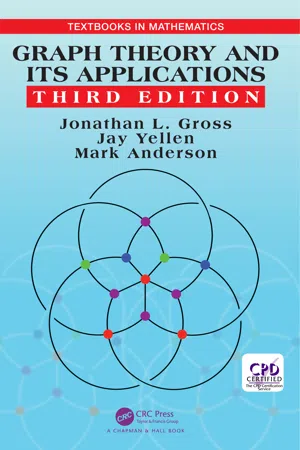
- 577 pages
- English
- ePUB (mobile friendly)
- Available on iOS & Android
Graph Theory and Its Applications
About this book
Graph Theory and Its Applications, Third Edition is the latest edition of the international, bestselling textbook for undergraduate courses in graph theory, yet it is expansive enough to be used for graduate courses as well. The textbook takes a comprehensive, accessible approach to graph theory, integrating careful exposition of classical developments with emerging methods, models, and practical needs.
The authors' unparalleled treatment is an ideal text for a two-semester course and a variety of one-semester classes, from an introductory one-semester course to courses slanted toward classical graph theory, operations research, data structures and algorithms, or algebra and topology.
Features of the Third Edition
- Expanded coverage on several topics (e.g., applications of graph coloring and tree-decompositions)
- Provides better coverage of algorithms and algebraic and topological graph theory than any other text
- Incorporates several levels of carefully designed exercises that promote student retention and develop and sharpen problem-solving skills
- Includes supplementary exercises to develop problem-solving skills, solutions and hints, and a detailed appendix, which reviews the textbook's topics
About the Authors
Jonathan L. Gross is a professor of computer science at Columbia University. His research interests include topology and graph theory.
Jay Yellen is a professor of mathematics at Rollins College. His current areas of research include graph theory, combinatorics, and algorithms.
Mark Anderson is also a mathematics professor at Rollins College. His research interest in graph theory centers on the topological or algebraic side.
Frequently asked questions
- Essential is ideal for learners and professionals who enjoy exploring a wide range of subjects. Access the Essential Library with 800,000+ trusted titles and best-sellers across business, personal growth, and the humanities. Includes unlimited reading time and Standard Read Aloud voice.
- Complete: Perfect for advanced learners and researchers needing full, unrestricted access. Unlock 1.4M+ books across hundreds of subjects, including academic and specialized titles. The Complete Plan also includes advanced features like Premium Read Aloud and Research Assistant.
Please note we cannot support devices running on iOS 13 and Android 7 or earlier. Learn more about using the app.
Information
Chapter 1
INTRODUCTION TO GRAPH MODELS
Introduction
1.1 GRAPHS AND DIGRAPHS
Table of contents
- Cover
- Half Title
- Series Page
- Title Page
- Copyright Page
- Dedication
- Table of Contents
- Preface
- Authors
- 1 Introduction to Graph Models
- 2 Structure and Representation
- 3 Trees
- 4 Spanning Trees
- 5 Connectivity
- 6 Optimal Graph Traversals
- 7 Planarity and Kuratowski’s Theorem
- 8 Graph Colorings
- 9 Special Digraph Models
- 10 Network Flows and Applications
- 11 Graph Colorings and Symmetry
- A Appendix
- B Bibliography
- Solutions and Hints
- Index of Applications
- Index of Algorithms
- General Index